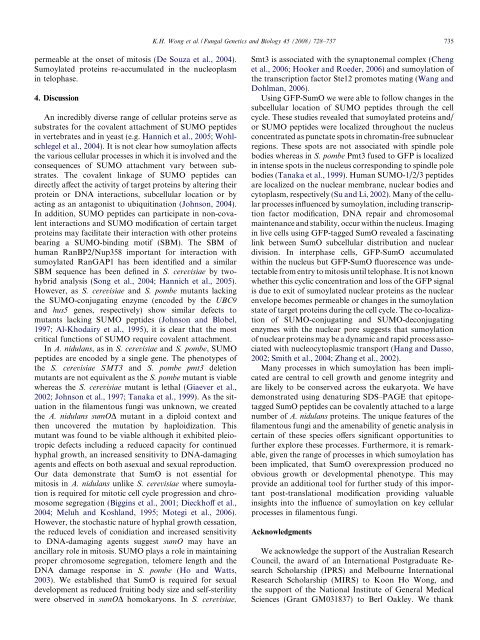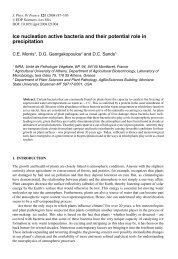Sumoylation in Aspergillus nidulans: sumO inactivation ...
Sumoylation in Aspergillus nidulans: sumO inactivation ...
Sumoylation in Aspergillus nidulans: sumO inactivation ...
You also want an ePaper? Increase the reach of your titles
YUMPU automatically turns print PDFs into web optimized ePapers that Google loves.
K.H. Wong et al. / Fungal Genetics and Biology 45 (2008) 728–737 735<br />
permeable at the onset of mitosis (De Souza et al., 2004).<br />
Sumoylated prote<strong>in</strong>s re-accumulated <strong>in</strong> the nucleoplasm<br />
<strong>in</strong> telophase.<br />
4. Discussion<br />
An <strong>in</strong>credibly diverse range of cellular prote<strong>in</strong>s serve as<br />
substrates for the covalent attachment of SUMO peptides<br />
<strong>in</strong> vertebrates and <strong>in</strong> yeast (e.g. Hannich et al., 2005; Wohlschlegel<br />
et al., 2004). It is not clear how sumoylation affects<br />
the various cellular processes <strong>in</strong> which it is <strong>in</strong>volved and the<br />
consequences of SUMO attachment vary between substrates.<br />
The covalent l<strong>in</strong>kage of SUMO peptides can<br />
directly affect the activity of target prote<strong>in</strong>s by alter<strong>in</strong>g their<br />
prote<strong>in</strong> or DNA <strong>in</strong>teractions, subcellular location or by<br />
act<strong>in</strong>g as an antagonist to ubiquit<strong>in</strong>ation (Johnson, 2004).<br />
In addition, SUMO peptides can participate <strong>in</strong> non-covalent<br />
<strong>in</strong>teractions and SUMO modification of certa<strong>in</strong> target<br />
prote<strong>in</strong>s may facilitate their <strong>in</strong>teraction with other prote<strong>in</strong>s<br />
bear<strong>in</strong>g a SUMO-b<strong>in</strong>d<strong>in</strong>g motif (SBM). The SBM of<br />
human RanBP2/Nup358 important for <strong>in</strong>teraction with<br />
sumoylated RanGAP1 has been identified and a similar<br />
SBM sequence has been def<strong>in</strong>ed <strong>in</strong> S. cerevisiae by twohybrid<br />
analysis (Song et al., 2004; Hannich et al., 2005).<br />
However, as S. cerevisiae and S. pombe mutants lack<strong>in</strong>g<br />
the SUMO-conjugat<strong>in</strong>g enzyme (encoded by the UBC9<br />
and hus5 genes, respectively) show similar defects to<br />
mutants lack<strong>in</strong>g SUMO peptides (Johnson and Blobel,<br />
1997; Al-Khodairy et al., 1995), it is clear that the most<br />
critical functions of SUMO require covalent attachment.<br />
In A. <strong>nidulans</strong>, as<strong>in</strong>S. cerevisiae and S. pombe, SUMO<br />
peptides are encoded by a s<strong>in</strong>gle gene. The phenotypes of<br />
the S. cerevisiae SMT3 and S. pombe pmt3 deletion<br />
mutants are not equivalent as the S. pombe mutant is viable<br />
whereas the S. cerevisiae mutant is lethal (Giaever et al.,<br />
2002; Johnson et al., 1997; Tanaka et al., 1999). As the situation<br />
<strong>in</strong> the filamentous fungi was unknown, we created<br />
the A. <strong>nidulans</strong> <strong>sumO</strong>D mutant <strong>in</strong> a diploid context and<br />
then uncovered the mutation by haploidization. This<br />
mutant was found to be viable although it exhibited pleiotropic<br />
defects <strong>in</strong>clud<strong>in</strong>g a reduced capacity for cont<strong>in</strong>ued<br />
hyphal growth, an <strong>in</strong>creased sensitivity to DNA-damag<strong>in</strong>g<br />
agents and effects on both asexual and sexual reproduction.<br />
Our data demonstrate that SumO is not essential for<br />
mitosis <strong>in</strong> A. <strong>nidulans</strong> unlike S. cerevisiae where sumoylation<br />
is required for mitotic cell cycle progression and chromosome<br />
segregation (Bigg<strong>in</strong>s et al., 2001; Dieckhoff et al.,<br />
2004; Meluh and Koshland, 1995; Motegi et al., 2006).<br />
However, the stochastic nature of hyphal growth cessation,<br />
the reduced levels of conidiation and <strong>in</strong>creased sensitivity<br />
to DNA-damag<strong>in</strong>g agents suggest <strong>sumO</strong> may have an<br />
ancillary role <strong>in</strong> mitosis. SUMO plays a role <strong>in</strong> ma<strong>in</strong>ta<strong>in</strong><strong>in</strong>g<br />
proper chromosome segregation, telomere length and the<br />
DNA damage response <strong>in</strong> S. pombe (Ho and Watts,<br />
2003). We established that SumO is required for sexual<br />
development as reduced fruit<strong>in</strong>g body size and self-sterility<br />
were observed <strong>in</strong> <strong>sumO</strong>D homokaryons. In S. cerevisiae,<br />
Smt3 is associated with the synaptonemal complex (Cheng<br />
et al., 2006; Hooker and Roeder, 2006) and sumoylation of<br />
the transcription factor Ste12 promotes mat<strong>in</strong>g (Wang and<br />
Dohlman, 2006).<br />
Us<strong>in</strong>g GFP-SumO we were able to follow changes <strong>in</strong> the<br />
subcellular location of SUMO peptides through the cell<br />
cycle. These studies revealed that sumoylated prote<strong>in</strong>s and/<br />
or SUMO peptides were localized throughout the nucleus<br />
concentrated as punctate spots <strong>in</strong> chromat<strong>in</strong>-free subnuclear<br />
regions. These spots are not associated with sp<strong>in</strong>dle pole<br />
bodies whereas <strong>in</strong> S. pombe Pmt3 fused to GFP is localized<br />
<strong>in</strong> <strong>in</strong>tense spots <strong>in</strong> the nucleus correspond<strong>in</strong>g to sp<strong>in</strong>dle pole<br />
bodies (Tanaka et al., 1999). Human SUMO-1/2/3 peptides<br />
are localized on the nuclear membrane, nuclear bodies and<br />
cytoplasm, respectively (Su and Li, 2002). Many of the cellular<br />
processes <strong>in</strong>fluenced by sumoylation, <strong>in</strong>clud<strong>in</strong>g transcription<br />
factor modification, DNA repair and chromosomal<br />
ma<strong>in</strong>tenance and stability, occur with<strong>in</strong> the nucleus. Imag<strong>in</strong>g<br />
<strong>in</strong> live cells us<strong>in</strong>g GFP-tagged SumO revealed a fasc<strong>in</strong>at<strong>in</strong>g<br />
l<strong>in</strong>k between SumO subcellular distribution and nuclear<br />
division. In <strong>in</strong>terphase cells, GFP-SumO accumulated<br />
with<strong>in</strong> the nucleus but GFP-SumO fluorescence was undetectable<br />
from entry to mitosis until telophase. It is not known<br />
whether this cyclic concentration and loss of the GFP signal<br />
is due to exit of sumoylated nuclear prote<strong>in</strong>s as the nuclear<br />
envelope becomes permeable or changes <strong>in</strong> the sumoylation<br />
state of target prote<strong>in</strong>s dur<strong>in</strong>g the cell cycle. The co-localization<br />
of SUMO-conjugat<strong>in</strong>g and SUMO-deconjugat<strong>in</strong>g<br />
enzymes with the nuclear pore suggests that sumoylation<br />
of nuclear prote<strong>in</strong>s may be a dynamic and rapid process associated<br />
with nucleocytoplasmic transport (Hang and Dasso,<br />
2002; Smith et al., 2004; Zhang et al., 2002).<br />
Many processes <strong>in</strong> which sumoylation has been implicated<br />
are central to cell growth and genome <strong>in</strong>tegrity and<br />
are likely to be conserved across the eukaryota. We have<br />
demonstrated us<strong>in</strong>g denatur<strong>in</strong>g SDS–PAGE that epitopetagged<br />
SumO peptides can be covalently attached to a large<br />
number of A. <strong>nidulans</strong> prote<strong>in</strong>s. The unique features of the<br />
filamentous fungi and the amenability of genetic analysis <strong>in</strong><br />
certa<strong>in</strong> of these species offers significant opportunities to<br />
further explore these processes. Furthermore, it is remarkable,<br />
given the range of processes <strong>in</strong> which sumoylation has<br />
been implicated, that SumO overexpression produced no<br />
obvious growth or developmental phenotype. This may<br />
provide an additional tool for further study of this important<br />
post-translational modification provid<strong>in</strong>g valuable<br />
<strong>in</strong>sights <strong>in</strong>to the <strong>in</strong>fluence of sumoylation on key cellular<br />
processes <strong>in</strong> filamentous fungi.<br />
Acknowledgments<br />
We acknowledge the support of the Australian Research<br />
Council, the award of an International Postgraduate Research<br />
Scholarship (IPRS) and Melbourne International<br />
Research Scholarship (MIRS) to Koon Ho Wong, and<br />
the support of the National Institute of General Medical<br />
Sciences (Grant GM031837) to Berl Oakley. We thank









